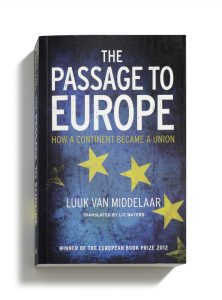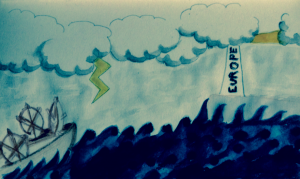Luuk, tell us a story !
The book The Passage to Europe by Luuk Van Middelaar
Luuk van Middelaar succeeds in analysing the history of the EU with many anecdotes, figurative expressions and narratives. The history is made of political discourses of European actors, circles of political relationships and major events. It is analysed through notions, philosophical considerations and theories which allow discussing it: a rare occurrence! Linguistics also helps the narrative and analysis. The word “passage” is rather used than “building” or “integration”. What means building? It is a construction site, outside the flow of history, in which everyone participates (discourse of citizens). Integration? It is a fusion wished by the European bureaucracy. “The passage to Europe” rather involves a progression over time in a certain direction. Let’s hit the road!
One, two, three! Three discourses on the future of Europe compete with each other: the confederal discourse of states, the federal discourse of citizens and the functionalist discourse of bureaucracy (functionalism implies that Europe would be given state powers). These three discourses integrate hybrid forms of political systems like supranationalism (a system with higher powers), intergovernmentalism (cooperation between member states until the 90’s) and constitutionalism (consideration of Europe through a constitution giving it higher powers than states). There are a lot of political concepts to dissociate!
At the European level, political relationships are organised in three circles: the external circle of states, the internal circle of the European Community and the intermediary circle of member states which is embodied by the European Council. Luuk van Middelaar particularly enhanced the latter circle: the highlight of his analysis. This intermediary circle overlaps the other two. This circle was organised through balance of powers then by the law, while the external sphere is organised through balance of powers between states and the internal sphere by the European treaties. Guess where start the passage to Europe?
 Based on these discourses, circles and also events, Luuk Van Middelaar fragments the history of the EU in three “lines of forces”: the ability of the EU to renew itself, the involvement of heads of states and the support of the public. Clearly, Luuk is passionate about the number three!
Based on these discourses, circles and also events, Luuk Van Middelaar fragments the history of the EU in three “lines of forces”: the ability of the EU to renew itself, the involvement of heads of states and the support of the public. Clearly, Luuk is passionate about the number three!
Take a trip through history! For modern thinkers like Thomas Hobbes, John Locke and Jean-Jacques Rousseau, founding a state requires the passage to majority vote in order to operate as political community. For Luuk, Europe does not require it. Moreover the Treaty of Rome of 1957 only planned majority voting in the Council in 1966! The European political community has rather taken the form of a club, the Council’s club, since the Treaty of Paris of 1951. Let’s go to the club!
The first leaps forward Europe have been made by the case-law of the European Union Court of Justice (former ECCJ). The Court has ordered the compliance with European rules by national jurisdictions (judgment of the Court of 5 February 1963. – Van Gend & Loos versus the Netherlands tax authorities) and the supremacy of Community law (judgment of the Court of 15 July 1964. Flaminio Costa versus E.N.E.L.). Two years later, the Luxembourg compromise postponed the passage to majority voting: it enforced unanimity voting in the European Council when national issues of vital interest were at stake. This was the result of Charles De Gaulle’s policy of the empty chair. Nevertheless the compromise has recognized the existence of the intermediary circle, i.e. a European political space without threat to the Community.
Being a club member is more important than formal decision rules to decide collectively at the European level. Besides, states and populations never ratified a European treaty by majority vote. Consensus has prevailed so far. However, in 1985 during the Milan Summit the European Council did plan by majority voting an intergovernmental conference to revise European treaties. The European Council has legitimised itself in this way as an institution able to take responsibility for European decisions on behalf of peoples.
A political body is usually defined by the rules for its modification. The EU is not autonomous in its renewal given that the modification of its treaties requires both constituted power (European institutions) and constituent power (states, governments, parliaments, peoples). Though, heads of states have gained the power to develop the EU. A flexibility clause has been created during the Paris Summit in 1972 allowing the increase of powers of the European Community without any modification of treaties in order to achieve its goals.
After the foundation of the European political community until 1957, Luuk van Middelaar distinguishes two “passage” periods: a wait-and-see policy and an intervention period after the collapse of the Berliner wall. To identify and structure these times, he used Machiavelli’s concepts of “luck” (impromptu events) and of “virtu” (ability to act as events unfold). He considers European capacity for action particularly towards the outside world as “major policy”. To face luck the intermediary circle needs a capacity for action and a great sense for responsibility. If you want an extremely brief summary of his analysis, please go on reading!
After the foundation period, the issue of accession of new member states (beginning with the United-Kingdom) has forced the member states to think themselves as an internal unity and to be aware of their political existence.
After the collapse of the Berliner wall, the Community’s evolution to an Union (Treaty of Maastricht of 1992) has separated the power to act of each state and has politicized their alliance especially regarding foreign policies.
Citizens, support Europe! Lastly, Luuk Van Middelaar looks to the successive European strategies of modern states to attract citizens. How citizens could accept and support the decisions of a political system they did not build? Luuk uses here the concept of “institutional fact” of the philosopher John Searl. Searl defined institutional fact as common acceptance of the role or function of an entity. Luuk reflects on this question through the types of political rules of Hebert Hard: primary rules for individual behaviors and secondary rules for the rules themselves. These two types require acceptance by the population. How do we foster the acceptance of European rules and powers?
The EU has implemented the German strategy trying with difficulty to convince of a cultural and historical identity shared by those ruling and those ruled. It has sought thus to develop a feeling of belonging through a declaration on European identity in 1973, through cultural policies, a logo-flag, an hymn, a day, a glorification of founding fathers and great figures (Charlemagne, Erasmus,Galileo, Socrates, Leonardo da Vinci…) and through a currency. The author considers the German strategy may be used again when European borders will be defined, ending the arbitrary self-definition of Europe and allowing the production of a narrative history.
The EU has partly carried out the Roman strategy which highlights advantages for the population of peace between member states. To make peace possible the EU has become a major public financing body, decided of policies to protect and support citizens, of socio-economic policies, has offered civil rights, and conducted surveys on populations (eurobarometers). In Luuk’s opinion, this strategy, mostly a communication one, mentions neither its costs regarding politicization, democratic sovereignty and solidarity nor differences of interests (benefit for some actors). Besides, it does not foster collective awareness.
Finally, the EU has tried to develop the Greek strategy by periodically assessing its representatives. It has created a parliament, organised elections and built a citizenship. The Greek strategy can be implemented through two methods: it gives citizens a role in the decision-making process (participant or spectator) or it plays a drama.
In relation to the role of citizens, the European Parliament did not succeed in representing the voice of peoples. The author explains it by the sharing of power between the constituent power and the constituted power and by the sharing of democratic legitimacy between the European Council and the European Parliament. This legitimacy exists through referendums on the foundations of the EU when national citizens can express strongest positions. It also exists through withdrawal from the EU.
Luuk van Middelaar identifies the challenges of European referendums. The latter are very clear about accession to the EU (future of a nation, place of a nation in the continent) but more vague about the change of European fundamental rules (future of rules, reassessment of the founding pact). Luuk clarifies campaign strategies which were implemented during European referendums. The contentious practices were disseminated in order to reject European rules while the European order was promoted in order to support these rules. Specific strategies were used towards reluctant populations (parliamentary ratification of a treaty like the Treaty of Lisbon, and transformation into a plebiscite on the EU like the Treaty of Maastricht in the Netherlands or like the Constitutional Treaty and the Treaty of Lisbon in Ireland).
To gain legitimacy, the EU has attempted to reach national electorate involving national parliaments in the legislative process since the Treaty of Lisbon.
In relation to the play of a European drama, the EU meets several barriers. To perform in 23 languages is not that simple. Moreover, since the two world wars, the EU has searched for consensus and for a display of neutrality. Luuk van Middelaar considers that the EU needs now to showcase European confrontations. This is the purpose of his book. In the absence of European advertising, Luuk explains that national public spheres provide opportunities to create narratives, disseminate events and actions as confrontations thanks to the acting of political actors and of media as “professional storytellers”.
